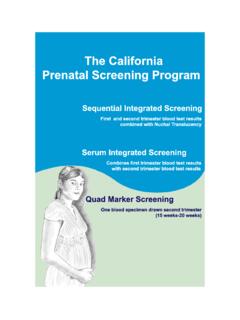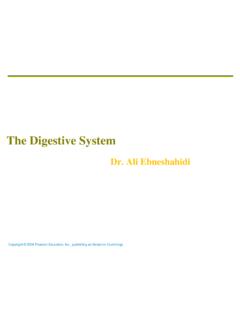Transcription of NIT 5 - NCERT
1 UNIT 5. HUMAN PHYSIOLOGY. Chapter 16 The reductionist approach to study of life forms resulted in increasing Digestion and Absorptionuse of physico-chemical concepts and techniques. Majority of these studies employed either surviving tissue model or straightaway cell- Chapter 17 free systems. An explosion of knowledge resulted in molecular biology. Breathing and Exchange Molecular physiology became almost synonymous with biochemistry of Gases and biophysics. However, it is now being increasingly realised that neither a purely organismic approach nor a purely reductionistic Chapter 18 molecular approach would reveal the truth about biological processes Body Fluids and or living phenomena.
2 Systems biology makes us believe that all living Circulation phenomena are emergent properties due to interaction among components of the system under study. Regulatory network of molecules, Chapter 19 supra molecular assemblies, cells, tissues, organisms and indeed, Excretory Products and populations and communities, each create emergent properties. In the their Elimination chapters under this unit, major human physiological processes like digestion, exchange of gases, blood circulation, locomotion and Chapter 20 movement are described in cellular and molecular terms. The last two Locomotion and Movement chapters point to the coordination and regulation of body events at the organismic level.
3 Chapter 21. neural Control and Coordination Chapter 22. Chemical Coordination and Integration 2015-16(19/01/2015). ALFONSO CORTI, Italian anatomist, was born in 1822. Corti began his scientific career studying the cardiovascular systems of reptiles. Later, he turned his attention to the mammalian auditory system. In 1851, he published a paper describing a structure located on the basilar membrane of the cochlea containing hair cells that convert sound vibrations into nerve impulses, the organ of Corti. He died in the year 1888. Alfonso Corti (1822 1888). 2015-16(19/01/2015). CHAPTER 16.
4 DIGESTION AND ABSORPTION. Digestive Food is one of the basic requirements of all living organisms. The major System components of our food are carbohydrates, proteins and fats. Vitamins Digestion of and minerals are also required in small quantities. Food provides energy Food and organic materials for growth and repair of tissues. The water we take in, plays an important role in metabolic processes and also prevents Absorption of dehydration of the body. Biomacromolecules in food cannot be utilised Digested Products by our body in their original form. They have to be broken down and converted into simple substances in the digestive system.
5 This process of Disorders of conversion of complex food substances to simple absorbable forms is Digestive called digestion and is carried out by our digestive system by mechanical System and biochemical methods. General organisation of the human digestive system is shown in Figure DIGESTIVE SYSTEM. The human digestive system consists of the alimentary canal and the associated glands. Alimentary Canal The alimentary canal begins with an anterior opening the mouth, and it opens out posteriorly through the anus. The mouth leads to the buccal cavity or oral cavity. The oral cavity has a number of teeth and a muscular tongue.
6 Each tooth is embedded in a socket of jaw bone ( ). This type of attachment is called thecodont. Majority of mammals including human being forms two sets of teeth during their life, a set of 2015-16(19/01/2015). 258 BIOLOGY. Oral cavity Parotid gland Mouth Pharynx Submaxillary and sublingual glands Oesophagus Liver Gall bladder Stomach Pancreas Duodenum Transverse colon Jejunum Ascending colon Descending colon Ileum Caecum Rectum Vermifor m appendix Anus Figure The human digestive system temporary milk or deciduous teeth replaced by a set of permanent or adult teeth. This type of dentition is called diphyodont.
7 An adult human has 32 permanent teeth which are of four different types (Heterodont dentition), namely, incisors (I), canine (C), premolars (PM) and molars (M). Arrangement of teeth in each half of the upper and lower jaw in the order I, C, PM, M is represented by a dental formula which in human 2123. is . The hard chewing surface of the teeth, made up of enamel, helps 2123. in the mastication of food. The tongue is a freely movable muscular organ attached to the floor of the oral cavity by the frenulum. The upper surface of the tongue has small projections called papillae, some of which bear taste buds.
8 The oral cavity leads into a short pharynx which serves as a common passage for food and air. The oesophagus and the trachea (wind pipe). 2015-16(19/01/2015). DIGESTION AND ABSORPTION 259. open into the pharynx. A cartilaginous flap called epiglottis prevents the entry of food into the glottis opening of the wind pipe . during swallowing. The oesophagus is a thin, long tube which extends posteriorly passing through the neck, thorax and diaphragm and leads to a J' shaped bag like structure called stomach. A muscular sphincter (gastro-oesophageal) regulates the opening of oesophagus into the stomach.
9 The stomach, located in the upper left portion of the abdominal cavity, has three major parts a cardiac portion into which Figure Arrangement of different types of the oesophagus opens, a fundic region and teeth in the jaws on one side and a pyloric portion which opens into the first the sockets on the other side part of small intestine (Figure ). Small intestine is distinguishable into three regions, a C' shaped duodenum, a long coiled middle portion jejunum and a highly coiled ileum. The opening of the stomach into the duodenum is guarded by the pyloric sphincter. Ileum opens into the large intestine.
10 It consists of caecum, colon and rectum. Caecum is a small blind sac which hosts some symbiotic micro-organisms. A. narrow finger-like tubular projection, the vermiform appendix which is a vestigial organ, arises from the caecum. The caecum opens into the colon. The colon is divided into three parts an ascending, a transverse and a descending part. The descending part opens into the rectum which opens out Figure Anatomical regions of human through the anus. stomach The wall of alimentary canal from oesophagus to rectum possesses four layers (Figure ) namely serosa, muscularis, sub-mucosa and mucosa.
















